AMD vs. Intel: Battery Life Investigated
by Jarred Walton on August 5, 2009 5:00 PM EST- Posted in
- Laptops
Laptops: Comparing Apples to Apples
Anyone looking to go out and purchase a new laptop is almost certainly interested in a couple things: how much does it cost, and what sort of battery life can you expect? Answering those questions for any specific laptop is simple enough, provided we can get a sample unit for testing. However, it becomes more difficult to answer these questions when you're looking at the big picture -- i.e. AMD vs. Intel laptops. The pricing question is easier: laptops using AMD platforms are (usually) cheaper than equivalent Intel platform laptops. That's simple enough: you're paying more for the Intel brand. But what about battery life?
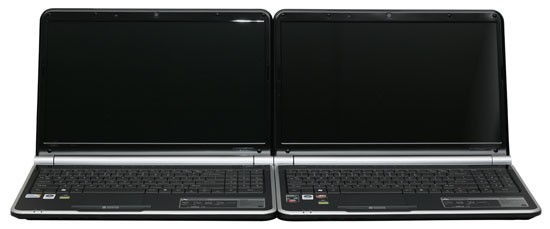 |
We have long tried to answer that question, but the best we could do up until this point was to compare "similar" laptops. Getting the same LCD, hard drive, optical drive, and most importantly battery has been very difficult -- so difficult that we have not been able to do it. A few manufacturers offer competing AMD and Intel laptops with very similar specifications, but no one seemed willing to send their AMD-based system. Were they afraid of cannibalizing sales of their more expensive laptops? Did they just think that an AMD-based laptop wouldn't stand up well in our testing? We don't know for sure, but what we do know is that Gateway has stepped up to the plate and sent us two all but identical laptops. We've been busy the past week or two putting the laptops through our test regimen, and we will have the full review shortly. In the meantime, we thought you might be particularly interested in the battery life you can expect.
Here's a quick look at the two laptops. On top is the AMD-based Gateway NV52, and below it is the Intel-based Gateway NV58.
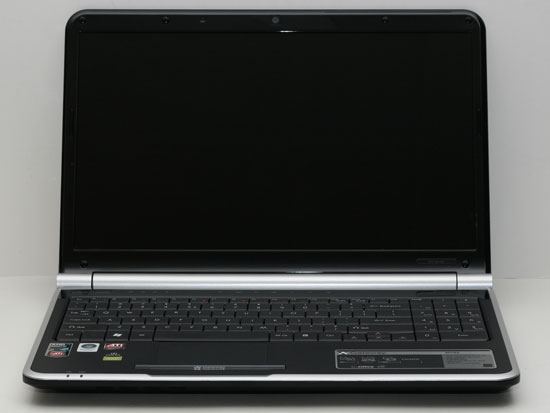 |
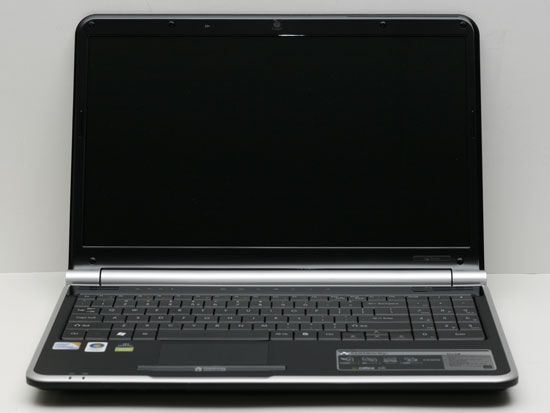 |
Here's a second look, focusing on the keyboards. Once again, AMD is above and Intel is below.
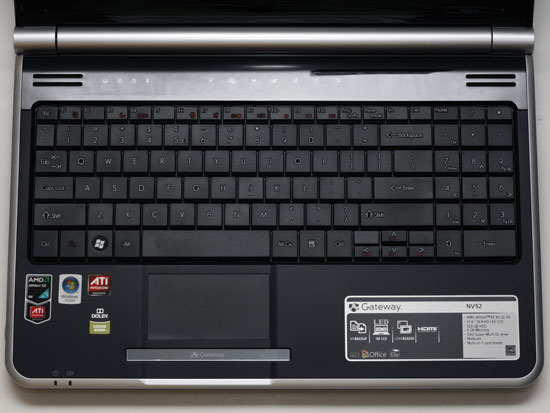 |
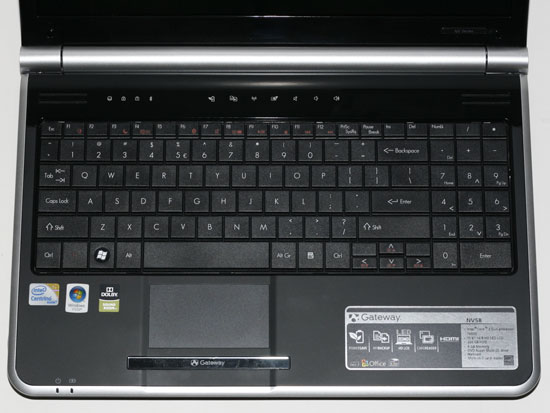 |
The chassis are identical from the outside, and everything else is the same as well other than the motherboard, chipset, and processor. Both come with 4GB DDR2 memory, a 15.6" 1366x768 LED backlit LCD, 320GB 5400 RPM hard drive, and a DVDRW. Both also include Gigabit Ethernet and 802.11n WiFi (Intel WiFi Link 5100 for the NV58 and Atheros AR928X for the NV52). In fact, even the CPUs have the same 2.1 GHz clock speed -- not that CPU clock speed matters -- as well as 35W TDP ratings -- not that that matters either, as we'll soon see. On the AMD side, we have the QL-64 (65nm, 2.1GHz, 2x512K L2, 3600MHz HyperTransport bus), and on the Intel laptop we have the T6500 (45nm, 2.1GHz, 2MB shared L2, 800MHz FSB). We should also mention that the NV58 costs more than the NV52, $500 for the NV52 and $580 for the NV58. What does the extra $80 buy you?
We will have performance numbers in our upcoming full review, but considering this is a match between AMD's old dual-core Athlon 64 X2 (K8 architecture) and Intel's Core 2 Duo, you can probably already guess the results. Intel is quite a bit faster in all of the CPU benchmarks. On the other hand, the AMD platform comes with much better integrated graphics, so if you would like to do a bit of 3D gaming on occasion (at low to medium detail levels) AMD easily wins the graphics benchmarks. Now let's look at battery life.










80 Comments
View All Comments
snakeoil - Wednesday, August 5, 2009 - link
so this is another 'sort of review'? come on.this happen always when they do an amd review.after the 'sort of review' they come with and update where they say that they commmited a 'mistake' and the amd product have a problem so they think the intel hardware wins.
anyway.
doncerdo - Wednesday, August 5, 2009 - link
If you pit a C2D architecture CPU against an Athlon architecture chip, the results are more than obvious and writing this article is a waste of time. It is the same as testing a P4 notebook against an Athlon notebook for power consumption with no testing one already can guess the results. Wasn't the recent Turion lineup with slipt power planes and core redesign a major reason for improved power consumption on the AMD platform? If so, why test previous generation CPUs?Another reason not to like this previews at AT emotions get in the way of objective testing...we already had a retraction in the morning with the 785G article. I really prefer full articles instead of these "beta" (best way I can describe it) writeups.
Exar3342 - Thursday, August 6, 2009 - link
AMD has ignored the laptop market for a long time and has never really engineered a mobile-only CPU in the same focus as Intel. I don't think anyone would argue that AMD's mobile GPUs are better than Intel's, but when it comes down to standard laptop usage, Intel beats AMD hand's down. Intel has better power management, and has a whole suite of ULV processors that kick the pants off AMD's offerings. AMD needs to get it's head out of their a@@ and realize the mobile market is HUGE, and they are neglecting it.thurston - Wednesday, August 5, 2009 - link
I agree, I don't care for the preview articles either, but it got me to read Anandtech tonight, so I suppose it works for them.coldpower27 - Wednesday, August 5, 2009 - link
Actually AMD uses Athlon 64x2 branding for it's mobile line... take a look here:http://products.amd.com/en-us/NotebookCPUDetail.as...">http://products.amd.com/en-us/NotebookC...=&f6...
http://products.amd.com/en-us/NotebookCPUDetail.as...">http://products.amd.com/en-us/NotebookC...=&f6...
doncerdo - Wednesday, August 5, 2009 - link
I thought mentioning the different power planes would make you realize we are talking about Turion Ultra. Those CPUs with the Lion core for example that start with RM designation and are part of the Puma platform. So my post stands based on the fact that at least this CPUs were redesigned with mobility in mind and were not simply cherry picked low TDP parts.JarredWalton - Wednesday, August 5, 2009 - link
They may have split power planes (didn't AMD already have some issues with that and CnQ on the desktop?) but they're still by and large the same K8 dual-core CPU that we've had for years. As for the "Lion" CPUs, you might want to recheck your information. AFAIK, Althon X2 QL-64 is a "Lion" processor, just like the Turion X2 RM and ZM lines. (Not that http://en.wikipedia.org/wiki/List_of_AMD_Turion_mi...">Wikipedia hasn't been wrong in the past....)mczak - Wednesday, August 5, 2009 - link
Turion Ultra (with Lion core) should have a bit better battery life (despite same TDP) than Athlon X2 mobile (with Lion core) since the former seems to also support (as already mentioned) more power states, deeper sleep, lower min p-state, and adjustable HT frequency. Well, maybe. It should also be slightly faster (because of twice the cache). I'd say all of that would only probably make a marginal difference however.As for 45nm parts, Tigris/Caspian should appear later this year - Caspian just looks like mobile regor to me. Chipset is rather unexciting (rs880m) but I'd guess the cpus (caspian) could have a bit higher frequency with the same power draw than lion (or alternatively same frequency with lower power draw), together with the improved IPC of K10 that could be enough to make them competitive with lower end core2 duo offerings. Not sure why it's not released yet actually, it really looks to me like amd would desperately need this new platform and all ingredients already exist as desktop parts.
JarredWalton - Wednesday, August 5, 2009 - link
The real problem is that on mobile systems, AMD just doesn't appear to have any answer to Core 2. On desktops, there's Phenom II at least, but that's the size of Core i7 so it's no surprise they aren't cramming that into a laptop. AMD's CPU names are also confusing; Turion X2 is higher spec than Athlon X2 on mobile systems, but there's a ton of overlap and unfortunately this is the closest we could get. Still, the only sub-30W CPUs listed at AMD are the Athlon X2 QL-62 (25W) and the Athlon X2 TK-42 (20W).If you look at the http://products.amd.com/en-us/NotebookCPUResult.as..." target="_blank">complete list, all the other dual-core AMD CPUs are 35W TDP except:
Turion X2 ZM-80 (32W)
Turion X2 RM-70 (31W)
Turion X2 TL-56 (31W/33W)
Turion X2 TL-58 (31W)
The most attractive based off specs would have to be the QL-62, considering the 25W rating vs. 31-35W, so despite the higher performance designs in most instances I'm not sure the Turion line is universally better. If I can get a ZM-80, I'll try to install it in the NV52 and see what it does for power/battery results. Even if it can improve battery life, the T6500 is still about 30-35% faster, and T6500 isn't even remotely high-end.
K6III - Thursday, August 6, 2009 - link
It seems that bringing the Athlon II to the mobile market makes a lot of sense. 45nm and smaller core than existing Athlon64 X2, many of the same performance enhancements as PhenomII, and potentially similar/lower power draw compared to Core2.